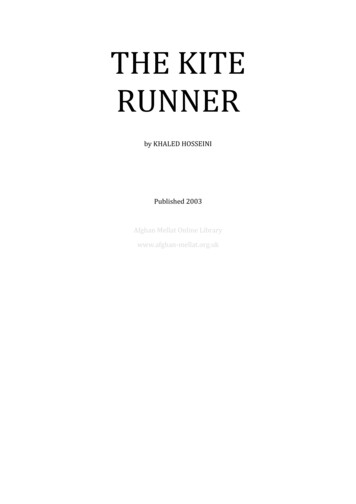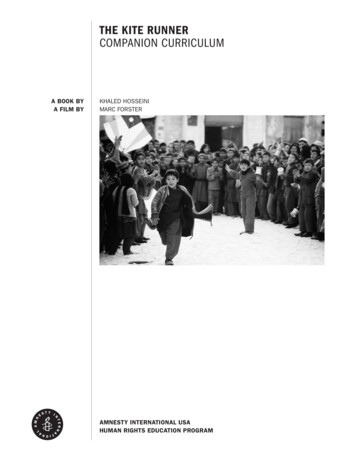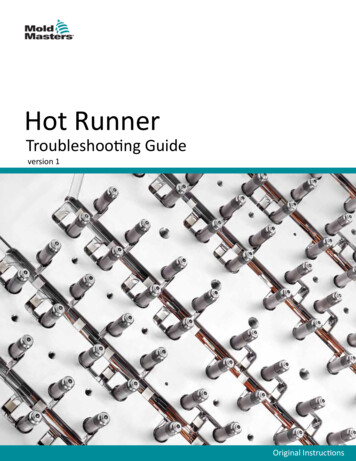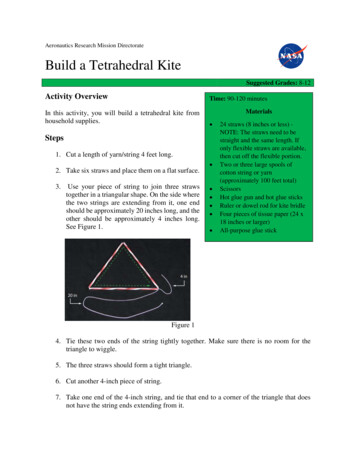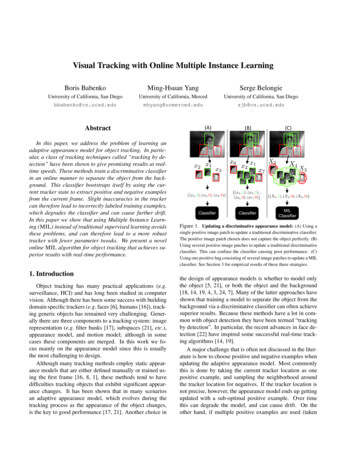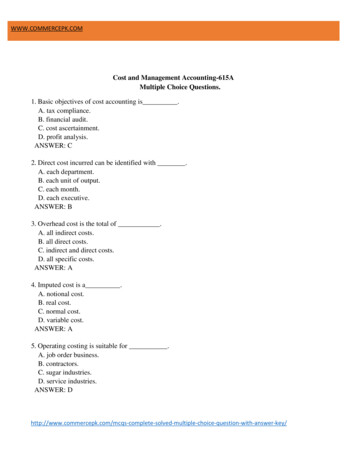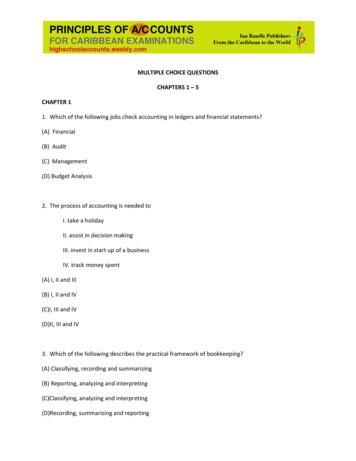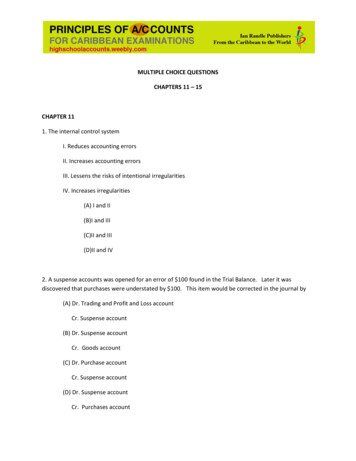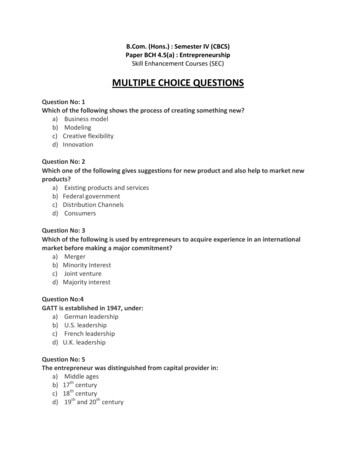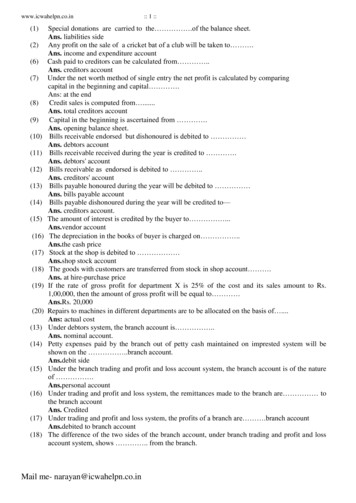
Transcription
SamplePrestwick HouseMultiple CriticalPerspectives Prestwick HouseTeaching Khaled Hosseini’sThe Kite RunnerfromMultiple Critical Perspectives Click hereto learn moreabout thisMultiple CriticalPerspectives! Click hereto find moreClassroom Resourcesfor this title! Prestwick HouseMore from Prestwick HouseLiteratureLiterary Touchstone ClassicsLiterature Teaching UnitsGrammar and WritingCollege and Career Readiness: WritingGrammar for WritingVocabularyVocabulary Power PlusVocabulary from Latin and Greek RootsReadingReading Informational TextsReading Literature
Multiple CriticalPerspectivesTeaching Khaled Hosseini'sThe Kite Runnerfrom Multiple Critical PerspectivesbyKelli Kuntz
Multiple CriticalPerspectivesThe Kite RunnerGeneral Introduction to the WorkIntroduction to The Kite RunnerTHEKITE RUNNER IS A NOVEL with strong elements of historical fiction. It is a story in which the settingplays a significant role in the plot, and the social, cultural, and historical background directly affectthe characters’ lives and the plot’s events.One thing that is crucial to the creation of effective historical fiction is the authenticity of the author’sportrayal of time and place. Characters in historical fiction may be either imaginary people or portrayals of actual historical figures. In The Kite Runner, the characters are all imaginary, but encounter realhistorical events— most notably the Russian invasion and the Taliban takeover. These real events affectthe fictional plot and characters. Baba and Amir escape to Pakistan and then to America because the Russians make life too difficult for them. Hassan is fearful of the Taliban and is later killed by them. Amir’sreturn to Kabul as an adult is fictional, but may represent the actual condition of the city. The orphanagewhere Sohrab had been kept may represent the condition of actual orphanages, and Assef’s public stoningof people for adultery may represent actual events during the Taliban rule. Hosseini also makes a briefreference to the attacks on the World Trade Center on September, 11, 2001, near the end of the novel.Additionally, he describes the activism of Amir and Soraya, as well as the change in the American peopleand their newly acquired knowledge of and interest in Afghanistan. These details probably represent realexperiences for Afghan-Americans.The Kite Runner is told from the first-person limited perspective. Amir narrates the entire story fromhis own point of view, making the descriptions and experiences recorded inherently one-sided. The reader cannot rely on objectivity in the book because every event is filtered through Amir’s memories, biases,and emotions. While several events in the story really occurred, descriptions of characters and situationsare Amir’s interpretation.6PR E S T W I C KHO U S E,IN C.
The Kite RunnerMultiple CriticalPerspectivesMarxist ApproachApplied to The Kite RunnerNotes on the Marxist ApproachTHEMARXIST APPROACH TO LITERATURE is based on the philosophy ofKarl Marx, a German philosopher and economist. His major argu-ment was that whoever controlled the means of production in societycontrolled the society—whoever owned the factories “owned” the culture. This idea is called “dialectical materialism,” and Marx felt thatthe history of the world was leading toward a communist society. Fromhis point of view, the means of production (i.e., the basis of power insociety) would be placed in the hands of the masses, who actually operated them, not in the hands of those few who owned them. It was aperverted version of this philosophy that was at the heart of the SovietUnion. Marxism was also the rallying cry of the poor and oppressed allover the world.To read a work from a Marxist perspective, one must understand thatMarxism asserts that literature is a reflection of culture, and that culturecan be affected by literature (Marxists believed literature could instigaterevolution). Marxism is linked to Freudian theory by its concentrationon the subconscious—Freud dealt with the individual subconscious,while Marx dealt with the political subconscious. Marx believed that oppression exists in the political subconscious of a society—social peckingorders are inherent to any group of people.Four main areas of study: economic power materialism versus spirituality class conflict art, literature, and ideologiesPR E S T W I C KHO U S E,IN C.13
The Kite RunnerMultiple CriticalPerspectivesActivity OneDefining Amir as a Tourist in Afghanistan1.Copy and distribute the handout The Kite Runner: Marxism Activity One Worksheet.2.Divide the class into groups of two or three.3.Have students read Farid’s speech from Chapter 19 in which he tells Amir that he has been a touristin Afghanistan all of his life.4.Have students follow the instructions on the handout, study the text, and answer the questions.5.Reconvene the class and allow each group to report its findings.6.As a full class, discuss the following questions: Does the relationship between Amir and Farid serve as a representation of the struggle betweensocial classes? How do Amir’s and Farid’s lives differ as a result of social class? Is Amir’s social class different in the United States from what it is in Afghanistan? Why?PR E S T W I C KHO U S E,IN C.17
The Kite RunnerMultiple CriticalPerspectivesFeminist ApproachApplied to The Kite RunnerNotes on the Feminist ApproachFEMINISM IS AN EVOLVING PHILOSOPHY.Feminism in literature is aneven newer area of study and thought. The basis of the movement,both in literature and society, is that the Western world is fundamentally patriarchal (i.e., created by men, ruled by men, viewed throughthe eyes of men, and judged by men).The social movement of feminism found its approach to literaturein the 1960s. Of course, women had already been writing and publishing for centuries, but the 1960s saw the rise of a literary theory. Untilthen, the works of female writers (or works about females) were examined by the same standards as those by male writers (and about men).Women were thought to be unintelligent (at least in part because theywere generally less formally educated than men), and many womenaccepted that judgment. It was not until the feminist movement waswell under way that women began examining old texts to reevaluatetheir portrayal of women and writing new works to fit the “modernwoman.”The feminist approach is based on finding suggestions of misogyny (negative attitudes about women) within pieces of literature andexposing them. Feminists are interested in exposing elements in literature that have been accepted as the norm by both men and women.They have even dissected many words in Western languages that areclearly rooted in masculinity. Feminists argue that since the past millennia in the West have been dominated by men—whether they be thepoliticians in power or the historians recording it all—Western literature reflects a masculine bias and, consequently, represents an inaccurate and harmful image of women. In order to fix this image and createa balanced canon, works by females and works about females shouldbe added and judged on a different, feminine scale.PR E S T W I C KHO U S E,IN C.25
The Kite RunnerMultiple CriticalPerspectivesActivity OneExamining the Lack of Women in The Kite Runner1.Copy and distribute the worksheet for The Kite Runner Feminist Activity One.2.Briefly, in class discussion, list all of the female characters who play a role—major and minor—in thenovel.3.Divide the class into pairs or small groups.4.Have the students complete the chart on the handout, indicating women who are introduced inAfghanistan and those introduced in the United States on the right. Then, have them describe eachwoman’s role and evaluate her significance to the story.5.Reconvene the class and discuss the role of women in the novel: Are there any major female characters in the novel? If so, who are they, and what role(s) do they play? What is the significance of the fact that neither Amir’s nor Hassan’s mother is a character in the book? What is especially significant about Hassan’s mother’s absence? What roles do Amir’s and Hassan’s wives play in the novel? What impact do they have on their husbands’lives? How do they affect the plot of the novel? The theme? Overall, how much impact do female characters have on the story? Why? Are the female characters in this novel round or flat? Static or dynamic? Are they integral to the novelor merely functional? From a feminist perspective, what conclusions can you draw from the role(s) of women in this novel?PR E S T W I C KHO U S E,IN C.29
The Kite RunnerMultiple CriticalPerspectivesNew Historicist ApproachApplied to The Kite RunnerNotes on New HistoricismACOMMON TENDENCY IN THE STUDYof literature written in, and/orset in, a past or foreign culture is to assume a direct comparisonbetween the culture as presented in the text and as that culture reallywas/is. New Historicism asserts that such a comparison is impossiblefor two basic reasons. First, the “truth” of a foreign or past culture cannever be known as established and unchangeable. At best, any understanding of the “truth” is a matter of interpretation on the parts of boththe writer and the reader. This is most blatantly evident in the fact thatthe “losers” of history hardly ever get heard. The culture that is dominated by another culture is often lost to history because it is the powerful that have the resources to record that history. Even in recent pastevents, who really knows both sides of the story? Who really knowsthe whole of the Nazi story? Or the Iraqi story? New Historicists arguethat these unknown histories are just as significant as the histories ofthe dominant culture and should be included in any world view. Sincethey often contradict “traditional” (i.e., the winner’s) history, there isno way to really know the ironclad truth. Second, while the text underconsideration does indeed reflect the culture in which it was written(and to some degree in which it is set), it also participates in the culturein which it is written. In other words, its very existence changes theculture it “reflects.” To New Historicists, literature and culture are bornof one another. For example, although Harper Lee’s To Kill a Mockingbird certainly reflected the culture of the south during the mid-20thcentury, it also became a tool to raise awareness of and change certainelements of that culture.PR E S T W I C KHO U S E,IN C.39
The Kite RunnerMultiple CriticalPerspectivesActivity OneUnderstanding Khaled Hosseini and His Creation of The Kite Runner1.Copy and distribute the handouts Khaled Hosseini Fact Sheet and Inferences About Khaled Hosseini’sBeliefs, Values, and Opinions.2.Divide the class into three groups (or a number of groups divisible by three).3.Assign each, or allow each to choose, one of the following topics (from the Inferences handout): Race / Ethnic Relations Social Class Relations Historical Events4.Have each group divide the novel as it chooses and examine the novel for evidence of Hosseini’sviews of its assigned topic.5.Reconvene the class and have each group report its findings.6.As a class, discuss the nature of the view of Afghan life and culture provided by Hosseini. Has hesucceeded in doing as his wife suggested: “to show the world a different side of Afghanistan: an Afghanistan as a community of families, consisting of people oppressed and driven into poverty by themujahideen and the Taliban”?PR E S T W I C KHO U S E,IN C.43
The Kite Runner Perspectives Activity One Examining the Lack of Women in The Kite Runner 1. Copy and distribute the worksheet for The Kite Runner Feminist Activity One. 2. Briefl y, in class discussion, list all of the female characters who play a role—major and minor—in the novel. 3. Divide the class into pairs or small groups. 4.File Size: 1MB
